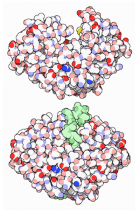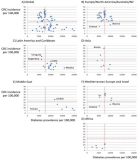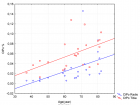Table of Contents
Diagnostic accuracy of Magnetic Resonance Imaging to differentiate benign and Malignant Parotid Gland Tumors
Published on: 7th November, 2018
OCLC Number/Unique Identifier: 7929251620
Objective: To determine the diagnostic accuracy of Magnetic Resonance Imaging (MRI) to differentiate Benign and Malignant Parotid Gland Tumors taking histopathology as gold standard.
Design: Cross sectional study.
Place and duration of study: Department of Diagnostic Radiology, Lahore General Hospital, Lahore from January till July 2014.
Methodology: 200 patients of age between 5 to 80 years of either gender with parotid gland swelling, having radiological evidence and clinical suspicion of parotid tumour like fixation to underlying skin, pain, facial palsy and cervical lymphadenopathy were taken. T1 and T2 plain and contrast enhanced 1.5 Tesla MRI unit using standard imaging coil was then carried out. Imaging was further evaluated for the presence or absence of benign or malignant parotid gland tumours using histopathology as a Gold standard. Sensitivity, specificity, positive predictive value, negative predictive value and diagnostic accuracy of MRI were taken against the gold standard.
Results: There were 170 males and 30 females having mean age of 40.27±15.04 and 40.12±12.15 years respectively. Sensitivity, specificity, positive predictive value and negative predictive value of MRI were 90.4%, 89.33%, 93.39% and 84.41% respectively. The diagnostic accuracy of MRI to differentiate benign and malignant parotid gland tumours was 90%. These results were taken against surgery histopathology as a gold standard.
Conclusion: MRI is highly accurate in differentiating malignant & benign tumours of parotid glands and can be used as an adjunct to histopathology for pre-operative evaluation of the parotid gland tumours.
Percentage of Positive Biopsy Cores Predicts Presence of a Dominant Lesion on MRI in Patients with Intermediate Risk Prostate Cancer
Published on: 12th October, 2018
OCLC Number/Unique Identifier: 7900048359
Background: Biopsy findings of percentage of positive biopsy cores, percentage of cancer volume, and maximum involvement of biopsy cores have been shown to have prognostic value and correlate with magnetic resonance imaging (MRI) findings of extracapsular extension and seminal vesicle invasion. The relationship of these prognostic biopsy factors to MRI findings of the presence of a dominant lesion, has not yet been investigated.
Methods: Sixty-five patients with intermediate risk prostate cancer were included in a retrospective cohort. MRI was acquired using either 1.5 Tesla (T) with endorectal coil or a 3 T MRI unit. Findings of extracapsular extension, seminal vesicle invasion, and presence and number of dominant lesions were noted. T-test and Cox regression statistical analyses were performed.
Results: Patients with one or more dominant lesions on MRI had a significantly higher mean percentage of positive biopsy cores (56.7% vs 39.8%, p=0.004), percentage of cancer volume (23.5% vs 14.5%, p=0.011) and maximum involvement of biopsy cores (62.9% vs 47.3%, p=0.027) than those without a dominant lesion on MRI. On multivariate analysis, only percentage of positive biopsy cores remained a statistically significant predictor for a dominant lesion on MRI (Hazard Ratio 1.06 [95% CI 1.01-1.12; p=0.02]), whereas prostate-specific antigen, clinical T-stage, Gleason score, percentage of cancer volume, and maximum involvement of biopsy cores were not significant predictors of a dominant lesion on MRI. Receiver-operator characteristic analysis was done and a cutoff value of >=50% was chosen for percentage of positive biopsy cores, >=15% for percentage of cancer volume, >=50% for maximum involvement of biopsy cores.
Conclusion: Percentage of positive biopsy cores was found to be a significant predictor for the presence of a dominant lesion on MRI. This finding is hypothesis-generating and should be confirmed with a prospective trial.
Dr. Saul Hertz Discovers the Medical Uses of Radioiodine (RAI)
Published on: 13th September, 2018
OCLC Number/Unique Identifier: 7856192339
Primary sources document Dr. Saul Hertz (1905 - 1950) as conceiving and developing radioiodine (RAI) as a diagnostic tool and as a therapy for thyroid diseases. Dr. Hertz was the first and foremost person to develop the experimental data on RAI and apply it to the clinical setting.
Saul Hertz was born on April 20,1905 to Jewish parents who had immigrated to Cleveland, Ohio. He received his A.B. from the University of Michigan in 1925 with Phi Beta Kappa honors. After graduating from Harvard Medical School in 1929, at a time of quotas for outsiders, he fulfilled his internship and residency at Cleveland’s Mt. Sinai Hospital.
In 1931, he came back to Boston to join the newly formed Thyroid Unit at The Massachusetts General Hospital serving as the Chief from 1931 - 1943.
Adaptive planning and toxicities of uniform scanning proton therapy for lung cancer patients
Published on: 10th September, 2018
OCLC Number/Unique Identifier: 7869162666
Purpose: Adaptive planning is often needed in lung cancer proton therapy to account for geometrical variations, such as tumor shrinkage and other anatomical changes. The purpose of this study is to present our findings in adaptive radiotherapy for lung cancer using uniform scanning proton beams, including clinical workflow, adaptation strategies and considerations, and toxicities.
Methods: We analyzed 165 lung patients treated using uniform scanning proton beams at our center. Quality assurance (QA) plans were generated after repeated computerized tomography (CT) scan to evaluate anatomic and dosimetric change during the course of treatment. Plan adaptation was determined mutually by physicists and physicians after QA plan evaluation, based on several clinical and practical considerations including potential clinical benefit and associated cost in plan adaption. Detailed analysis was performed for all patients with a plan adaptation, including the type of anatomy change, at which fraction the adaption was made, and the strategy for adaptation. Toxicities were compared between patients with and without plan adaptation.
Results: In total, 32 adaptive plans were made for 31 patients out of 165 patients, with one patient undergoing adaptive planning twice. Anatomy changes leading to plan adaptation included tumor shrinkage (17), pleural effusion (3), patient weight loss (2), and tumor growth or other anatomy change (9). The plan adaptation occurred at the 15th fraction on average and ranged from the 1st to 31st fraction. Strategies of plan adaptation included range change only (18), re-planning with new patient-specific hardware (9), and others (5). Most toxicities were Grade 1 or 2, with dermatitis the highest toxicity rate.
Conclusion: Adaptive planning is necessary in proton therapy to account for anatomy change and its effect on proton penetration depth during the course of treatment. It is important to take practical considerations into account and fully understand the limitations of plan adaptation process and tools to make wise decision on adaptive planning. USPT is a safe treatment for lung cancer patients with no Grade 4 toxicity.

HSPI: We're glad you're here. Please click "create a new Query" if you are a new visitor to our website and need further information from us.
If you are already a member of our network and need to keep track of any developments regarding a question you have already submitted, click "take me to my Query."



























































































































































